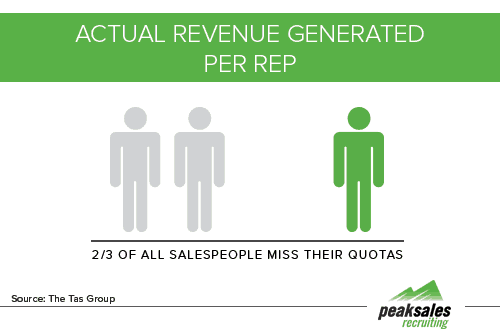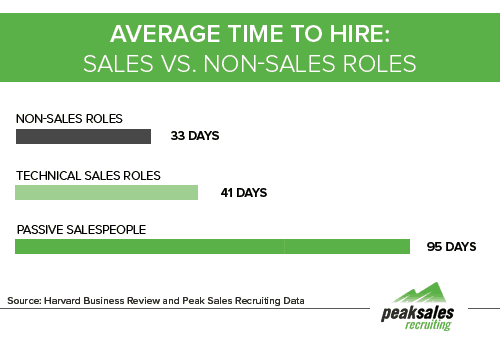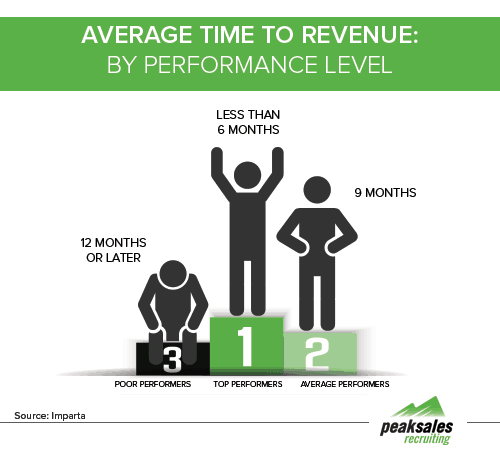Salespeople are the engine of a great company. They identify new opportunities for growth and are tasked with driving profitable revenue streams that propels organizations to achieve success. To help assess the effectiveness of their sales force, sales executives need to dive into their human capital metrics.
When viewed as pieces of a larger puzzle, core human capital metrics illuminate the complex workings of a sales organization and a team’s ability to achieve aggressive growth targets.
We focused on eight metrics that offer sales executives a bird’s eye view of the human aspect of sales. Analyzing this data helps provide sales leaders with the knowledge they need to build a better sales team that consistently drives higher rates of growth and organizational success.
Here are the human capital metrics every VP Sales needs to track:
1. Turnover Rates
Turnover rates reveal an organization’s ability to retain employees. If a company can’t keep their salespeople happy, they incur high costs associated with additional recruitment, poor performance and low morale. A recent Sales Effectiveness Survey from DePaul University revealed that the annual turnover rate for inside sales roles is 26.9 percent and 27.7 percent for outside sales roles, with a reported average cost per turnover at $97,690.
High voluntary turnover rates indicate larger issues at play such as below-average or poorly constructed compensation plans, or even a toxic sales culure. Leaders who experience consistently high voluntary turnover need to analyze feedback from employees in exit interviews. Candid conversations with departing sales reps are the quickest ways to discern the primary reasons for their departures.
High involuntary turnover rates, or a high percentage of reps being fired, indicate a poor sales hiring process. In 2015, The Bridge Group conducted a study surveying nearly 350 B2B SaaS companies and determined that the average sales rep involuntary turnover rate was 20% – making up nearly two-thirds of all annual attrition. This alarming statistic reveals a lack of structure in the B2B SaaS industry’s sales hiring process. World-class companies understand the substantial cost of a bad sales hire, and implement effective sales hiring processes to lower involuntary turnover rates.
Sales executives also benefit from examining turnover rates to find out what level of salesperson is leaving the company. Andris A. Zoltners, PK Sinha, and Sally E. Lorimer break down sales turnover into three categories: top performers, poor performers with high potential, or low performers with low potential. High performance sales organizations retain top performers and poor performers with potential. Below is a detailed diagnosis for transforming the turnover rate for three pools of employees:
Low Performers with Low Potential
A high turnover percentage among low performers with no potential to improve their sales performance points to problematic recruitment. While it’s important for sales leaders to quickly rid their teams of consistent under performers, effective sales leaders determine the root causes of their poor hiring practices.
Reassessing the characteristics of the ideal candidate profile and adopting a structured and rigorous recruiting processes is proven to reduce the risk of hiring bad salespeople. For more information on how to construct a structured and rigorous sales hiring process, download our eBook – Sales Recruiting 2.0
Low Performers with High Potential
Front-line sales managers are vital pieces that should be relied upon to help executives discern if a low-performing rep offers significant future potential based on performance reviews and the exemplified traits of the rep. The best method to increase retention among this category of salespeople is to bolster coaching and manager support during and after the onboarding process.
A structured schedule for the first three months of employment paired with a system of accountability for sales managers helps ensure sales team members are set up to reach their potential. HBR also recommends giving these salespeople “warm leads so that they can taste sales success, which is the ultimate motivator.” For more information on how to develop a structured onboarding process for new sales hires, download our eBook – The First 90 Days.
High Performers
High performers are a sales organization’s greatest asset — and biggest asset that can be lost. To reduce voluntary turnover among top performers, sales executives need to offer the rewards that high performers look for in competing companies: extra recognition, more freedom, better pay, long-term incentives, and a pro-sales culture.
2. Average Revenue Generated Per Rep
The average revenue generated per sales rep sheds light on two important aspects of a sales team — overall performance and the fairness of sales quotas. Ryan Tognazzini at Sales Benchmark Index suggests that if the average revenue is low, managers need to assess the strength of the sales pipeline. As he told Inc. Magazine, “It’s literally getting down into the weeds and understanding if the pipeline is real, and if there’s hope.”
If, however, the average revenue generated by each rep rises significantly above the sales quota, sales executives need to increase their benchmarks. Research from academic Steven W. Martin reveals that over 80 percent of high-performing sales organizations increase their quotas every year. Successful companies strike a balance by aiming for higher quotas that are still attainable to reps.
3. Actual Revenue Generated Per Rep
The revenue generated by individual reps gives managers a clear metric to assess the contributions of each salesperson and the achievement of the team as a whole. Research from The Tas Group indicates that two-thirds of all sales people miss their quotas, and 23 percent of surveyed companies don’t know if their teams are hitting quotas or not.
By contrast, the top 10 percent of firms surveyed by CSO Insights report that 75.1 percent of their reps either met or exceeded quota, achieving 116.7 percent of their company’s benchmark. The best sales leaders conduct an analysis to ensure that revenue generated aligns with specific revenue goals, such as new account acquisition or renewals.
The actual revenue generated per rep also indicates rep performance, giving managers important information about their contributions to a company. However, Fred Shilmover, CEO InsightSquared suggests that managers take a deeper approach to assessing the impact of this metric in From Impossible to Inevitable:
“Don’t be too quick to jump to conclusions and criticize or compliment anyone on the team right away. First look at their data to find out why and learn from it. A sales rep with highest consistent win rate may be talented at sales –– or talented at sandbagging/cherry picking. Don’t assume –– investigate.”
Sales executives can increase this metric by supporting individual performance with personalized talent development plans. Combined with heavy coaching, managers bridge skill gaps and radically impact the individual performance metrics of employees. This approach doesn’t mean that companies should keep bad hires, as research shows that top sales organizations cut chronic underperformers sooner rather than later.
4. Average Time to Hire
The average time it takes to hire a new employee from the original date of the job posting reflects both the competitiveness of the hiring market and the efficiency of a company’s recruitment process.
As baby boomers retire, the competition for top sales talent is steadily increasing. Bob Coughlin, a chief executive at Paycor, told The Wall Street Journal that a smaller sales talent pool meant his company missed out on $2 million more in 2015. Coughlin is not alone — the Harvard Business Review assessed that employers spent 41 days filling technical sales roles compared to 33 days for non-sales roles.
Glassdoor also supports that estimate; their researchers calculated 40 days as the average time it takes to hire a salesperson. Our own data suggests that across 3 industries (technology, professional services and industrial and manufacturing), the average time to hire a passive sales person — those who are actively and gainfully employed — and in the top 10% of their team, is 95 days.
The nature of a company’s recruitment processes also affects the average time to hire. By standardizing the procedure and focusing on qualified candidates who have achieved their sales targets year-over-year in the same or similar selling environments, sales leaders can decrease this metric over time.
An effective sales hiring process includes the following key elements:
- Establish an agreement on how the position and company will be communicated to candidates
- Establish a hiring benchmark and build an ideal candidate profile that defines critical sales skills and traits required for success in the position
- Hunt for only qualified, top performing salespeople
- Implement a rigorous and structured interviewing and assessment process
- 1st interview – high level qualification
- 2nd interview – skills and experience screening
- 3rd interview – behavioral interview, role playing, & psychometric assessment
- Submit an offer to the candidate that is most likely to drive consistent, profitable revenue
- Implement a structured onboarding program that sets new hires up for success
For more details on a standardized hiring procedure, read Hiring Salespeople: A Core Process You Must Perfect.
5. Average Ramp-Up Time
Companies measure ramp-up time in a range of different ways. However, a universal approach is to assess the time it takes for a rep to start significantly adding to a company’s revenue stream. (Based on the organization, executives can choose the most relevant supporting metrics, such as meeting monthly or quarterly quotas.)
The Revenue Conductor found a simple way to shorten the duration of this period. Their research concluded that employers who were most satisfied with their onboarding process experienced 34 percent faster ramp-up time for new sales reps. With the average ramp-up time of 10 months for B2B salespeople, a well-planned onboarding process can make a huge impact.
Increase early productivity by creating a structured training program that immerses new hires in company protocol and best practices. These onboarding programs should include both ‘classroom’ and in the field training, as well as concrete 30, 60 and 90-day goals that give new salespeople stepping stones toward yearly targets.
For a comprehensive look at how to implement an effective onboarding process, download our eBook: The First 90 Days – Your Guide to Making New Sales Hires Produce Fast.
6. Average Time to First Sale
The average time before a rep’s first sale serves as a benchmark for new hires. To coach new reps toward this goal, start tracking early and mid-stage indicators such as appointment setting and proposal generation to help build their confidence.
The most efficient leaders decrease the average time to first sale by hiring top performers. With 22 to 30 percent of salespeople lacking the skills to succeed at their jobs, recruitment is essential to ensure a strong average time to first sale.
If business development reps (BDRs) or inside sale reps struggle to make their first sale, sales managers need to change their tactics. Effective sales leaders direct new reps toward low-hanging fruit, giving them the opportunity to practice and get comfortable on the job. The positive momentum acquired by closing smaller transactional sales builds toward more lucrative deals.
7. Average Time to Revenue
The time to revenue is the average number of days between the date HR posted a job and when the new salesperson is profitable for their company.
Average Time to Hire + Average Ramp-Up Time = Average Time to Revenue
According to Imparta, a top performing salesperson will generate their first revenue in less than 6 months, while an average salesperson will generate their first revenue in 9 months, and a below average salesperson will generate first revenue in 12 months or later, or will never generate profitable revenue.
If the time to revenue surpasses nine months, it could be due to a slow recruitment process or a long ramp-up time. Leaders should investigate which challenge their organization faces — an instinct-based & non-objective hiring process, disorganized or poorly implemented onboarding processes, and poor front-line managers all contribute to a prolonged average time to revenue.
Tackle the issue by collaborating with HR and recruiters to examine each aspect of the recruitment and onboarding protocol to find the weak link. Since hiring and onboarding practices influence sales productivity, executives need to align those efforts with their goals.
8. Percentage of New Hires Meeting Sales Quotas
The percentage of new hires meeting their sales quotas points to the early successes (or failures) of new reps. If reps are failing to meet or exceed their quotas, an organization is hiring the wrong people or failing to train them correctly.
Mark Roberge, Hubspot’s Chief Revenue Officer, focuses on the coachability of job candidates during interviews. This approach ensures that new or ‘junior’ reps bring growth potential to their jobs. With the right coaching, great hires can steadily improve their performance. By pairing this method with a repeatable, formal sales process, Hubspot magnifies the early successes of their team.
Tom Hopkins, Sales Trainer and Chairman at Tom Hopkins International Inc., says that the answer to get more new hires to meet and exceed sales quota is through collaborative training and proper goal setting. “Before the training even begins, it’s important to set goals with the news hires – not for them. Salespeople will work much harder at achieving goals they’ve been involved in setting, than if goals or quotas are set by the company or a manager.”
Human Capital Metrics Matter
Human capital metrics are an integral aspect of assessing the rigor of a sales organization’s recruitment process, the effectiveness of its onboarding programs and the ability of managers to bring out the best in new hires. By tracking these statistics every quarter, sales executives gain a thorough understanding of what talent acquisition and retention methods are working — and what’s not working — within their organization.
relpost-thumb-wrapper
close relpost-thumb-wrapper
Eliot Burdett
Eliot received his B. Comm. from Carleton University and has been honored as a Top 40 Under 40 Award winner.
He co-authored Sales Recruiting 2.0, How to Find Top Performing Sales People, Fast and provides regular insights on sales team management and hiring on the Peak Sales Recruiting Blog.
Latest posts by Eliot Burdett (see all)
- 20 Of Our Favorite Books About Sales Management and Sales Leadership – October 20, 2023
- How To Make Progress On Your Sales Goal Without A Sales Leader – September 15, 2021
- Augment Your Recruiting Strategy During “The Great Resignation” – July 26, 2021








